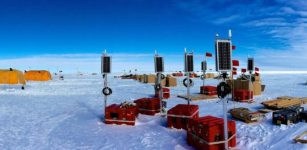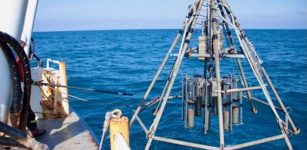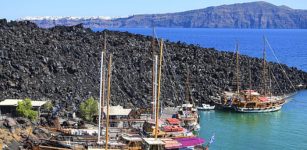From Mantle To Crust: Solving A Green Metal Mystery
Eddie Gonzales Jr. – MessageToEagle.com – Researchers from The University of Western Australia have created an experiment to explain the volcanic processes needed to transport green metals from the Earth’s interior to its surface.
Schematic illustrations of two compound globules with similar mineralogical assemblages but different morphologies. (A) Mineralogy and morphology of a compound globule with a clear rounded halo from the upper crustal Rudniy intrusion, Mongolia. (B) An example of an obscure volatile- and incompatible element-rich halo from the lower crustal Valmaggia pipe, Italy. Credit: Science Advances (2024). DOI: 10.1126/sciadv.adl3127
Dr. Maria Cherdantseva and Professor Marco Fiorentini, from UWA’s School of Earth Sciences, were co-authors of the study published in Science Advances.
“We reproduced the natural conditions that occur inside large volcanoes and found a secret ingredient must be added to magmas to enhance their potential to carry green metals,” Dr. Cherdantseva said.
Lead author Dr. Cherdantseva evoked the classic experiment of adding olive oil into a bowl of water and observing how the two liquids are unable to mix.
The study showed that in nature it is when a magmatic liquid known as carbonatite (oil) separates from magma (water) that green metals can be easily transported. Green metals display a strong physical attraction to carbonatite and tend to stick to it.
Due to the known low density of carbonatite, the carbonatite-metal pair would be notably lighter than the metal by itself, and even lighter than the surrounding magma.
“In essence, the carbonatite acts as a life jacket, preventing metals from drowning in the magma and facilitating their transport upwards,” Dr. Cherdantseva said.
“The carbonatite-metal pair is what we observe in the experiments and in nature.”
Previous research has tried to solve the puzzle of how metals such as nickel, platinum and copper, which are notably heavy and difficult to transport in magmas, make their way from the interiors of the planet to its surface.
“Mineral explorers can use this new knowledge to prioritize specific volcanoes in terms of the likelihood of green metals being present, thus maximizing the efficiency of the targeting process and minimizing the footprint on the environment,” Professor Fiorentini said.
“These results build on a body of knowledge on green metals, which are key resources essential for a sustainable, emission-free energy future.”
Written by Eddie Gonzales Jr. – MessageToEagle.com Staff Writer
Related Posts
-
 Detailed Study Links Fault Strength To The Likelihood Of Large Earthquakes
No Comments | Sep 10, 2024
Detailed Study Links Fault Strength To The Likelihood Of Large Earthquakes
No Comments | Sep 10, 2024 -
 A Glacier Fracture Speed Record At 80 mph Sheds Light On The Physics Of Ice Sheet Collapse
No Comments | Mar 4, 2024
A Glacier Fracture Speed Record At 80 mph Sheds Light On The Physics Of Ice Sheet Collapse
No Comments | Mar 4, 2024 -
 Sunken Worlds Under The Pacific? Current Understanding Of Plate Tectonics – Questioned
No Comments | Jan 8, 2025
Sunken Worlds Under The Pacific? Current Understanding Of Plate Tectonics – Questioned
No Comments | Jan 8, 2025 -
 Largest Ice Shelf In Antarctica Lurches Forward Once/Twice Each Day
No Comments | Mar 31, 2024
Largest Ice Shelf In Antarctica Lurches Forward Once/Twice Each Day
No Comments | Mar 31, 2024 -
 Debate Over Dinosaurs’ Demise – Now Let The Computers Decide
No Comments | Oct 4, 2023
Debate Over Dinosaurs’ Demise – Now Let The Computers Decide
No Comments | Oct 4, 2023 -
 Evidence Of Climate Change In The North Atlantic Can Be Seen In The Deep Ocean – New Study
No Comments | Nov 18, 2023
Evidence Of Climate Change In The North Atlantic Can Be Seen In The Deep Ocean – New Study
No Comments | Nov 18, 2023 -
 Faster Arctic Warming Hastens 2C Rise By Eight Years – UCL Study
No Comments | Nov 16, 2023
Faster Arctic Warming Hastens 2C Rise By Eight Years – UCL Study
No Comments | Nov 16, 2023 -
 Climate Drivers SAM And El Niño Affect Antarctic Ice Sheet
No Comments | Jul 15, 2024
Climate Drivers SAM And El Niño Affect Antarctic Ice Sheet
No Comments | Jul 15, 2024 -
 Scientific Drilling Unravels Historical Mystery Surrounding Santorini
No Comments | Mar 26, 2024
Scientific Drilling Unravels Historical Mystery Surrounding Santorini
No Comments | Mar 26, 2024 -
 Marine Mystery: Ice Cores Reveal Pollution’s Impact On Arctic Atmosphere
No Comments | Oct 1, 2024
Marine Mystery: Ice Cores Reveal Pollution’s Impact On Arctic Atmosphere
No Comments | Oct 1, 2024

